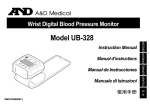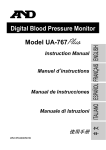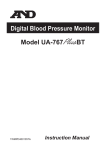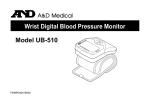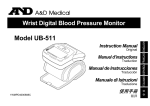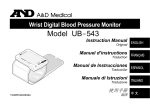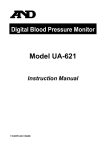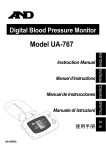Download A&D UB-328 Instruction manual
Transcript
Wrist Digital Blood Pressure Monitor Model UB-328 Instruction Manual Manuel d’instructions Manual de Instrucciones Manuale di Istruzioni WM+PD4000913 ENGLISH Dear Customers Congratulations. You have purchased an A&D blood pressure monitor, one of the most technologically advanced, yet easy to use products available in the marketplace today. We strongly recommend you read this instruction manual carefully prior to using it the first time. General Information This device conforms to the European Community Directive 93/42/EEC for Medical Products. This is evidenced by the CE mark of conformity accompanied by the reference number of a designated authority. This device is designed for monitoring your blood pressure and pulse rate at home. Therefore, intended use of this device is limited to monitoring blood pressure and pulse for the general public, except newborns and infants. Note: 1. This device is designed for personal use and not for public use. 2. This device is not designed for measuring newborns or infants. Using this device on newborns and infants could cause injury to the child. DO NOT USE on newborns or infants. Precautions 1. Precision components were used in the construction of this device. Extremes in temperature, humidity, direct sunlight, shock or dust should be avoided. 2. Clean the device with a dry, soft cloth. Never use thinner, alcohol, benzine, or wet cloths. 3. Avoid folding the cuff tightly or storing the hose tightly twisted for long periods, as such treatment may shorten the life of the components. 4. The device and cuff are not water resistant. Protect the device and cuff from rain, sweat and water. 5. Measurements may be impaired if the device is used close to televisions, microwave ovens, cellular telephones, X-ray or other devices with strong electrical fields. 6. Used equipment, parts and batteries are not treated as ordinary household waste, and must be disposed of according to applicable regulations. ENGLISH 1 Parts Identification ENGLISH 2 Symbols Symbols SN Function / Meaning Turns the device on and off. Guide to install battery Direct current Serial number Treatment ___________ ___________ ___________ ___________ Date of manufacture ___________ Type BF: Device, cuff and tubing are designed to ___________ provide special protection against electrical shocks. Appears when measurement is in progress and Measurement is in progress – remain still. flashes when the pulse is detected. Irregular Heartbeat indicator. (I.H.B.) ___________ The indicator that detects irregular heartbeats or any excessive body movement during the measurement. Previous measurement stored in MEMORY ___________ Appears when the battery voltage is too low for Replace all batteries with new ones. the device to work properly. Appears if the pressure value is unstable due to Try the measurement again. movement during the measurement. Appears if the pressure value is unstable due to Remain very still during the measurement. movement during the measurement. If your systolic reading exceeds 150 mmHg, read “For those Appears when inflation is not sufficient. whose systolic pressure is over 150 mmHg” on page 7. Appears when the cuff is not fastened correctly. Fasten the cuff correctly, and try the measurement again. Appears when the pulse is not detected correctly. Fasten the cuff correctly, and try the measurement again. ENGLISH 3 Systolic blood pressure in mmHg ___________ Diastolic blood pressure in mmHg ___________ Pulse beats per minute ___________ The EC directive medical device label ___________ Using the Monitor 1. Installing the batteries 1. Remove the battery holder cover. 2. Place two batteries (LR03 or AAA) in the holder, with positive (+) and negative (-) terminals matching those indicated in the holder. 3. Replace the battery holder cover until it is locked. • Insert the batteries as shown in the battery holder or the device will not work. • When (LOW BATTERY mark) appears in the display, replace all batteries with new ones at the same time. Do not mix old and new batteries. It may shorten the battery life, or cause the device to malfunction. • (LOW BATTERY mark) does not appear when the batteries are drained. • Battery life varies with the ambient temperature and may be shorter at low temperatures. • Remove the batteries if the device is not to be used for a long period of time. The batteries may leak and cause a malfunction. • Use the specified batteries only. The batteries provided with the device are for testing monitor performance and may have a shorter life. ENGLISH 4 Using the Monitor 2. Fastening the cuff 1. Wrap the cuff around your wrist, about 1 cm above your hand, as shown in the figure at the right. 2. Fasten the cuff tightly using the Velcro strip. Note: For proper measurements, fasten the cuff tightly and measure on a bare wrist. 3. How to take proper measurements For the most accurate blood pressure measurement: • • • • • Sit comfortably at a table. Rest your arm on the table. Relax for about five to ten minutes before measurement. Raise your hand so that the cuff is at the same level as your heart. Remain still and keep quiet during measurement. Do not measure right after physical exercise or a bath. Rest twenty or thirty minutes before taking the measurement. • Try to measure your blood pressure at the same time every day. 4. Measurement During measurement, it is normal for the cuff to feel very tight. (Do not be alarmed). 5. After measurement After measurement, press the START button to turn off the monitor. Remove the cuff and record your data. ENGLISH 5 Note: The device has an automatic power shut-off function, which turns off the power automatically one minute after measurement. Allow at least ten minutes between measurements on the same person. Measurements Note: The UB-328, once used, will provide an inflation appropriate to the user, based on the previous measurement. If your systolic pressure is expected to exceed 150 mmHg, read "For those whose systolic pressure is over 150 mmHg" on page 7. 1. Sit comfortably with the cuff at the same level as your heart and relax. 2. Press the START button. All display symbols appear briefly, then the display changes as indicated in the figure at the right when measurement begins. The cuff starts to inflate. It is normal for the cuff to feel very tight. Note: If you wish to stop inflation at any time, press the START button again. 3. When inflation is complete, deflation starts automatically and the (heart mark) appears to indicate that measurement is in progress. Once the pulse is detected, the mark flashes with each pulse beat. Note: If an appropriate inflation pressure is not obtained, the device starts to inflate again automatically. ENGLISH 6 4. When the measurement is complete, the systolic and diastolic pressure readings and pulse rate are displayed. The cuff exhausts the remaining air and deflates completely. 5. Press the START button again to turn off the monitor. Remove the cuff. Note: The device has an automatic power shut-off function. Allow at least ten minutes between measurements on the same person. Measurements For those whose systolic pressure is over 150 mmHg 1. Fasten the cuff around your wrist. Raise your arm so that the cuff is at the same level as your heart. 2. Press and hold the START button until a number about 30 to 40 mmHg higher than your expected systolic pressure appears. 3. When the desired number is reached, release the START button. Measurement will begin. Note: The operation above is required only when you measure your blood pressure for the first time. The next time, the UB-328 will provide an appropriate inflation, so measure your blood pressure as described on page 6. ENGLISH 7 Recalling Average Reading The UB-328 provides an average blood pressure reading based on the total measurements stored in memory. Press and release the Memory (“M”) button to see the average blood pressure reading. The average blood pressure reading will appear and the number of measurements stored in memory appear for approximately five seconds. Recalling Memory Data The UB-328 automatically stores up to 30 blood pressure and pulse measurements in its memory. Measurements stored in memory are assigned an index number in the order of the newest to the oldest. The oldest reading displays as “n01”. To retrieve readings, follow these simple steps: 1. When the display screen is blank, press and release the Memory button. You will see the average blood pressure reading displayed. Press and release the Memory button again. You will see the index number of the most recent reading followed by the measurement. 2. If you want to retrieve other measurements in memory, press and release the Memory button repeatedly until the desired index number is reached (e.g. n14). The measurement will then be displayed. 3. The display will shut off automatically a few seconds after the readings are displayed. To clear the measurement history from memory, remove the batteries from the unit and then place the batteries back into the battery holder. Note: If there are no measurements stored in memory, you will see two Os displayed vertically followed by a blinking “A00”. Note: Stored measurements will be lost if batteries become low or are removed. ENGLISH 8 What Is An Irregular Heartbeat? Model UB-328 blood pressure monitor provides a blood pressure and pulse rate measurement even when an irregular heartbeat occurs. An irregular heartbeat is defined as a heartbeat that varies by 25% from the average of all heartbeats during the blood pressure measurement. It is important that you are relaxed, remain still and do not talk during measurements. Note: We recommend contacting your physician if you see this indicator frequently. About Blood Pressure 1. What is blood pressure? Blood pressure is the force exerted by blood against the walls of the arteries. Systolic pressure occurs when the heart contracts. Diastolic pressure occurs when the heart expands. Blood pressure readings are usually given as two numbers: 120 over 80 (written as 120/80). The first number (120 in the example) is the systolic blood pressure. This represents the maximum pressure exerted as the heart contracts. The second number (80 in the example) is the diastolic pressure, the measurement taken between beats, when the heart is at rest. 2. What is hypertension and how is it controlled? Hypertension is abnormally high blood pressure. If left unattended, it can cause many health problems including stroke and heart attack. Hypertension can be controlled by altering lifestyle, avoiding stress and with medication under a doctor’s supervision. To help prevent hypertension or keep it under control: • Do not smoke. • Reduce salt and fat intake. ENGLISH 9 • Maintain proper weight. • Exercise regularly. • Have regular physical checkups. 3. Why measure blood pressure at home? Blood pressure measured at a clinic or doctor's office may cause apprehension or fear and can produce an elevated reading, 25 to 30 mmHg higher than that measured at home. Home measurement reduces the effects of outside influences on blood pressure readings, supplements the doctor's readings and provides a more accurate, complete blood pressure history. 4. WHO blood pressure classification Standards for assessment of high blood pressure, without regard to age, have been established by the World Health Organization (WHO), as shown in the chart to the right. ENGLISH 10 About Blood Pressure 5. Blood pressure variations An individual’s blood pressure varies greatly on a daily and seasonal basis. It may vary by 30 to 50 mmHg due to various conditions during the day. In hypertensive individuals, variations are even more pronounced. Normally, the blood pressure rises while at work or play and falls to its lowest levels during sleep. So, do not be overly concerned by the results of one measurement. Take measurements at the same time every day using the procedure described in this manual, and know your normal blood pressure. Multiple readings give a more comprehensive blood pressure history. Be sure to note the date and time when recording your blood pressure. Consult your doctor to interpret your blood pressure data. ENGLISH 11 Troubleshooting Problem Probable cause Corrective action Nothing appears in the display, even when the power is turned on. Batteries are drained. Replace all batteries with new ones. The cuff will not inflate. Battery voltage is too low. ( , LOW BATTERY mark appears). If the batteries are drained, the mark does not appear. Battery terminals are not in the correct Place the batteries with negative and positive terminals position. Batteries are not installed matching those indicated in the holder. properly. The device will not The cuff is not fastened properly. measure. Readings You moved your arm or body during are too high or too the measurement. low. The cuff position is not correct. Replace all batteries with new ones. Fasten the cuff correctly. Make sure you remain very still and quiet during the measurement. Adjust the cuff position. Raise your hand so that the cuff is at the same level as your heart. If you have a very weak or irregular heat beat, the device may have difficulty in determining your blood pressure. Other The value is different from that measured at a clinic or doctor’s office. See “3. Why measure blood pressure at home” on page 10. Remove the batteries. Place them back in correctly, and try the measurement again. Note: If the actions described above do not solve the problem, contact the dealer. Do not attempt to repair the device yourself. ENGLISH 12 Maintenance Do not open the device. It uses delicate electronic components and an intricate air unit that could be damaged. If you can not fix the problem using the troubleshooting instructions, request service from your supplier or from the A&D service group. The A&D service group will provide technical information, spare parts and units to authorized suppliers. The technical testing procedures, which should be done at least every two years, can be performed either by the manufacturer or by an authorized repair service in accordance with the regulations governing manufacturing of medical products. Technical Data Type Measurement method UB-328 Oscillometric measurement Measurement range Measurement accuracy Power supply Wrist circumference Classification Clinical test EMC Operating conditions Storage conditions Dimensions Weight Pressure: 20 - 280 mmHg, Pulse: 40 - 200 beats / minute Pressure: ±3 mmHg or 2%, whichever is greater, Pulse: ±5% 2 x 1.5V alkaline batteries (LR03 or AAA) 13.5 – 19.5 cm Type BF According to ANSI / AAMI SP-10 1987 IEC 60601-1-2:1993 +10 °C to +40 °C / 30%RH to 85 %RH −10 °C to +60 °C / 30%RH to 85 %RH Approx. 73 [W] x 58 [H] x 79 [D] mm, excluding cuff Approx. 120 g, excluding batteries Note: Specifications are subject to change without prior notice. ENGLISH 13 ENGLISH 14
















